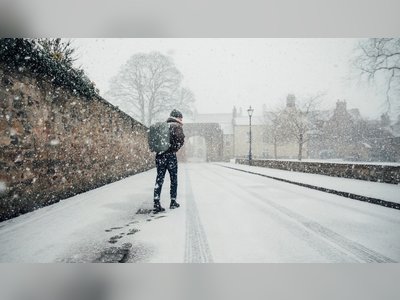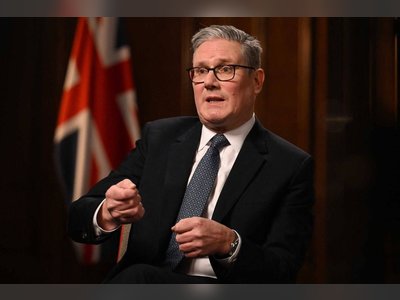
The Pandemic Is Ending
In millions of small ways, every day. How long it takes is up to us.
The deadliest virus in history was variola. For thousands of years, it stalked humanity, causing smallpox, a horrific fate. An infected person’s skin would suddenly erupt in blisters, papules, and vesicles. These would sometimes cover the eyes, and could grow together until the skin fell off, or fill with blood, or turn gray as the person bled internally. In the 20th century alone, the disease killed some 300 million people. Many survivors were scarred or blinded.
Before the invention of vaccines, some people would go to extreme lengths to gain immunity.“Variolation” involved purposely infecting a person with a small amount of a mild version of the smallpox virus, in the hopes that they would develop immunity. It was risky: Unlike today’s vaccines against COVID-19—which contain no living coronavirus—variolation was not predictably effective, and it caused some people to become gravely ill with smallpox.
For obvious reasons, the practice was controversial. Was protection from this plague worth the small chance of dying? In 1760, the renowned physiologist Daniel Bernoulli attempted to put the matter to rest. He was well known for his work predicting the movement of fluids in closed systems—to this day, high-school students learn of the physics principle that bears his name—and he sought to create a model for how life expectancies would differ if variolation were taken up widely. How would the damage compare with that of letting smallpox continue to spread?
The problem proved far more complex than Bernoulli’s mathematical model could even begin to account for. For one example, susceptibility to smallpox tended to vary greatly among different populations. For another, if the rates of disease were driven down by mass variolation, everyone’s risk of contracting smallpox would then fall. That would, subsequently, change an individual’s calculus as to whether variolation was worthwhile. In other words, the situation was dynamic. And people are complicated.
Bernoulli’s model wasn’t bad, but it was implausibly simplistic. In the centuries since, though, it has been credited with giving rise to the field of infectious-disease modeling. Mathematicians and scientists have sought to hone the process of risk assessment; to inform public-health predictions and recommendations; to give answers based on clear, objective statistics and calculations. Still, actual events never match up to even the most sophisticated models. As pathogenic microbes spread, they evolve, and human immune systems adapt in different ways, to different degrees, on different timescales. Human behavior and immunity contain far more variables than any projection could ever fully account for.
Predicting the course of SARS-CoV-2 has been especially difficult: This particular virus causes a disease that varies dramatically in both the nature and severity of symptoms, and basic preventive measures have been overtly politicized. Even though case numbers are improving, forecasting is more complex than ever before. What started out as one new virus is now many distinct strains, infecting populations that have different degrees of immunity and different levels of vaccination. As Anthony Fauci told me last week, pandemics themselves change depending on how we react to them. “It really is an evolution, in real time, of understanding something that you never experienced before,” he said. This is why he hates being asked about the future. “There are too many moving targets.” Despite the snippets that make it into headlines and sound bites, America’s most famous pandemic expert is extremely reluctant to make predictions about “returning to normal” at any specific time.
“The answer is, actually, we don’t know,” he said, calling from his car between TV appearances. But interviewers, he added, are rarely satisfied by that. He recounted a typical conversation: “But what’s your best guess? It’s dangerous to guess. But let’s say everything falls into place. When do you think that would be? Fall? Winter? You have variants. You have stumbling blocks. All right, give me the best-case scenario. I’ll give you the best-case scenario. But very often the best-case scenario doesn’t come out. Well, let’s say you do get people vaccinated. When do you think we could get back to some form of normality? Well, what do you think ‘form of normality’ is? I mean, normality is the way it was back in October of 2019? Well, who knows how long that’s going to take. We may need to be wearing masks in 2022 if the variants come in and they sort of thwart our vaccination efforts to get everything under control.”
Despite his consistent dodging and hedging, Fauci said, the human demand for certainty seems to drown out his actual answers. He imagines the headlines: “‘Fauci Says We’ll Have to Be Wearing Masks in 2022.’ No, I didn’t say that. ‘Fauci Says We’ll Be Back to Normal by the End of the Year.’ No, I didn’t say that either.” He sounded weary when we talked. “It’s dangerous to predict.”
We all want concise, concrete predictions. Attempting to minimize uncertainty is a universal human instinct, and the explicit mission of journalistic institutions. Yet efforts to eliminate uncertainty are bound to create more of it. Perhaps the most vexing lesson in epidemiology is that predictions themselves change the future. Bold forecasts have unintended consequences. When experts say that cases of COVID-19 are trending downward and the outlook for summer is rosy, for example, states start declaring victory and eliminating precautions. Even if you turn out to be exactly right about the capacity of a virus, people will react as it spreads, changing their behavior and altering prior patterns of transmission. Then, if you adjust your models and predictions accordingly, you are susceptible to criticism about “flip-flopping” or “changing your story.” Pandemic analysis is not a line of work for those afraid to update their conclusions as new evidence becomes available. It requires speaking despite uncertainty about the future, based on a keen eye for certainty in the present.
Last winter, the Harvard professor Marc Lipsitch became one of the first epidemiologists to speak on the record about what was actually going on. The novel coronavirus was being detected in multiple countries, and it clearly had properties with enormously destructive capacities. Few other experts seemed willing to take the leap and sound the alarm. They didn’t want to be wrong, or they didn’t want to cause panic, or some mix of both. The medical community had not forgotten the negative effects of the media’s attention on isolated cases of SARS, MERS, and Ebola, which had fueled racism and xenophobia, and caused fear of widespread illness that simply never came to pass in the United States. This time around, many scientists’ default position was to be calm and reassuring, telling people they didn’t yet have the evidence to say this coronavirus would become a pandemic.
Lipsitch and I first spoke on February 14, 2020, when the U.S. had 15 reported cases of COVID-19. At that point, he cautiously posited that the coronavirus would infect 40 to 70 percent of the U.S. population and likely become endemic. On February 24, when the U.S. had 52 confirmed cases, I included Lipsitch’s comments in a story with the headline “You’re Likely to Get the Coronavirus.” I tried to introduce them with as much context as possible. I deliberately buried the lede in the middle of a lengthy explanation of why I thought he was right. I spoke with vaccinologists who said that developing a vaccine would take at least a year. The virus had spread all around the world so quickly and stealthily that we already knew it was very different from SARS and MERS. America was doing very little testing, so case numbers were likely much higher than reported. And, crucially, we knew people could be asymptomatic. Taken together, the picture fit the bill for what Fauci had described to me in 2015 as “the perfect storm.”
The article was met with skepticism. The Associated Press called the headline “sensational” and insinuated that I had written the piece out of an interest in earning “a segment on Morning Joe.” Lipsitch himself received a torrent of concern that his estimate was premature or overly pessimistic. He later worried that his comments could be interpreted to mean that widespread infection was unavoidable, when what he meant to say was that this spread would happen unless we took drastic measures. Lipsitch was confident in his model and what he had told me, but mindful that if people thought this pandemic was inevitable, they would not even try to stop it, and would lose sight of how many lives could be saved by taking precautions and fortifying social and medical systems. “I still don’t know that there’s enough evidence to say that this was inevitable,” Lipsitch told me recently. “But by the time I started mouthing off to you, I thought it was very likely.”
A year later, “I have no illusion that I had the exact right calibration,” Lipsitch said, although he did have, essentially, the exact right calibration: The virus has now infected roughly 40 percent of Americans, killed more than 500,000, and is likely to become endemic. “But I think as early as I was able to put together the evidence, I said what I thought it meant. And I don’t know how to do better than that.”
Part of the reason Lipsitch was ultimately so correct is that he underestimated two major things. First was the extent to which, he told me last month, “bad leadership can screw up a response.” Meanwhile, he said, “the more positive surprise is the story of the vaccines, and the fact that, thanks to super-insightful planning, we had the infrastructure to build vaccines that work.” Ultimately, the extraordinary vaccine development may offset some of the Trump administration’s damage, and leave the world close to the worst-case scenario Lipsitch depicted a year ago.
In response to critics, Lipsitch has cited the work of the immunologist Peter Medawar, who warns in his book, Advice to a Young Scientist, of people who “affect the possession of a mind so finely critical that no evidence is ever quite good enough.” This position is always rhetorically defensible, because no hypothesis or scientific theory ever achieves certainty, by definition. Being proved wrong is hard if you say that you’d like to wait for more evidence before commenting. But that is, at some point, dishonest. Taken to its extreme, the insistence on waiting for more evidence can be malignant: climate denialism, anti-vaccination campaigns. It can also be paralyzing, which is especially dangerous in moments of crisis.
“You don’t ever want to let your desire not to panic people hold you back from something that you definitely know,” Fauci told me. “But when you just don’t know, you’ve got to walk a delicate balance.” You say and act on what you know, and you accept that some people will accuse you of flip-flopping when you later know more. “When people want to stick it to you, they say, ‘Oh, you said in the beginning that there isn’t anything that you do any different,’” Fauci said. “Tell me what you would have thought if we said, when you had the first case here, that we should absolutely shut the country down? They would have thrown me in jail.”
The Biden administration is much easier to work with than the Trump administration was, Fauci said. But last February, when the official line was that the virus was going to “disappear,” he was in an impossible situation. The people who could speak freely and also had the expertise to do so credibly were few. Today, the experts I trust most are those who seem to have grown less certain over the course of the pandemic, and have learned the humility it should force upon us all. Even last year, Lipsitch’s hesitation and hedging signaled to me that he knew what he was talking about. In July, he told me he was “out of the business” of prediction. Though if anyone should be in it, it’s him.
COVID-19 modeling is growing more sophisticated, but also more challenging. As scientists attempt to incorporate variables such as the many variants and the spectrum of immune responses around the world, messaging is also becoming more complex, defying the false binary of “lockdown” or “back to normal.” Perceptions of what should be done are now suffused with bias. The nature of that bias has changed radically in the past year. If, last February, journalists and experts were worried about panicking people, many of us now have a new default assumption: entertaining the worst possible scenarios.
The virus is evolving. Vaccines are never perfect. Things could still go very wrong. All of this is true. Our judgments tend to weigh recent experiences far more heavily than ones further back. Like a person recently in a car crash, we’re driving extra cautiously right now. Combine this with our short and ever-shortening memories, and our nature is to cycle between anxiety and complacency. Given the complexity of predictions, I have no illusion that I can accurately guess how people will react to my reporting or analysis. Focusing on potential risks may be useful, or it may lead to panic and pandemic fatigue. Erring toward optimism and away from undue alarm is what landed us here. Depicting a clear end point may relieve some stresses but worsen others. In a piece last month, the Atlantic contributor Zeynep Tufekci wrote: “Hope will get us through this. And one day soon, you’ll be able to hop off the subway on your way to a concert, pick up a newspaper, and find the triumphant headline: ‘COVID Routed!’” I would love for this to be true. I wish people still bought newspapers.
If anything can be said of what lies ahead, it’s that pandemics end in whimpers, not headlines. This one will end in many small ways, day by day, with concrete instances of triumph and progress to pull us forward. In other ways, this pandemic is going to drag on and on, and the virus will be with us indefinitely. The question is only to what degree. We don’t need to choose between urging caution and giving hope, between offering certainty and embracing ambiguity. Pandemics demand all of these things.
This is up to us. Disease modeling is complex, but the virus isn’t. As Lipsitch put it, “Epidemiology of infectious disease is, basically, one case becomes two. It’s not rocket science.” The virus itself is so simple as to not even qualify as a life-form. It’s a string of nucleic acid in a rudimentary shell. Its behavior is absolutely predictable—almost mechanical, like gravity. The complicating factor is us. And unlike the days of variolation, we now have many extremely safe and effective vaccines. We have modern technology to produce extremely effective masks and indoor ventilation systems. What must be done to save lives is just as clear as the mechanics of the virus itself. The path before us should involve extremely straightforward decisions. All we have to do is decide to make them. I have no certainty that we will.
Before the invention of vaccines, some people would go to extreme lengths to gain immunity.“Variolation” involved purposely infecting a person with a small amount of a mild version of the smallpox virus, in the hopes that they would develop immunity. It was risky: Unlike today’s vaccines against COVID-19—which contain no living coronavirus—variolation was not predictably effective, and it caused some people to become gravely ill with smallpox.
For obvious reasons, the practice was controversial. Was protection from this plague worth the small chance of dying? In 1760, the renowned physiologist Daniel Bernoulli attempted to put the matter to rest. He was well known for his work predicting the movement of fluids in closed systems—to this day, high-school students learn of the physics principle that bears his name—and he sought to create a model for how life expectancies would differ if variolation were taken up widely. How would the damage compare with that of letting smallpox continue to spread?
The problem proved far more complex than Bernoulli’s mathematical model could even begin to account for. For one example, susceptibility to smallpox tended to vary greatly among different populations. For another, if the rates of disease were driven down by mass variolation, everyone’s risk of contracting smallpox would then fall. That would, subsequently, change an individual’s calculus as to whether variolation was worthwhile. In other words, the situation was dynamic. And people are complicated.
Bernoulli’s model wasn’t bad, but it was implausibly simplistic. In the centuries since, though, it has been credited with giving rise to the field of infectious-disease modeling. Mathematicians and scientists have sought to hone the process of risk assessment; to inform public-health predictions and recommendations; to give answers based on clear, objective statistics and calculations. Still, actual events never match up to even the most sophisticated models. As pathogenic microbes spread, they evolve, and human immune systems adapt in different ways, to different degrees, on different timescales. Human behavior and immunity contain far more variables than any projection could ever fully account for.
Predicting the course of SARS-CoV-2 has been especially difficult: This particular virus causes a disease that varies dramatically in both the nature and severity of symptoms, and basic preventive measures have been overtly politicized. Even though case numbers are improving, forecasting is more complex than ever before. What started out as one new virus is now many distinct strains, infecting populations that have different degrees of immunity and different levels of vaccination. As Anthony Fauci told me last week, pandemics themselves change depending on how we react to them. “It really is an evolution, in real time, of understanding something that you never experienced before,” he said. This is why he hates being asked about the future. “There are too many moving targets.” Despite the snippets that make it into headlines and sound bites, America’s most famous pandemic expert is extremely reluctant to make predictions about “returning to normal” at any specific time.
“The answer is, actually, we don’t know,” he said, calling from his car between TV appearances. But interviewers, he added, are rarely satisfied by that. He recounted a typical conversation: “But what’s your best guess? It’s dangerous to guess. But let’s say everything falls into place. When do you think that would be? Fall? Winter? You have variants. You have stumbling blocks. All right, give me the best-case scenario. I’ll give you the best-case scenario. But very often the best-case scenario doesn’t come out. Well, let’s say you do get people vaccinated. When do you think we could get back to some form of normality? Well, what do you think ‘form of normality’ is? I mean, normality is the way it was back in October of 2019? Well, who knows how long that’s going to take. We may need to be wearing masks in 2022 if the variants come in and they sort of thwart our vaccination efforts to get everything under control.”
Despite his consistent dodging and hedging, Fauci said, the human demand for certainty seems to drown out his actual answers. He imagines the headlines: “‘Fauci Says We’ll Have to Be Wearing Masks in 2022.’ No, I didn’t say that. ‘Fauci Says We’ll Be Back to Normal by the End of the Year.’ No, I didn’t say that either.” He sounded weary when we talked. “It’s dangerous to predict.”
We all want concise, concrete predictions. Attempting to minimize uncertainty is a universal human instinct, and the explicit mission of journalistic institutions. Yet efforts to eliminate uncertainty are bound to create more of it. Perhaps the most vexing lesson in epidemiology is that predictions themselves change the future. Bold forecasts have unintended consequences. When experts say that cases of COVID-19 are trending downward and the outlook for summer is rosy, for example, states start declaring victory and eliminating precautions. Even if you turn out to be exactly right about the capacity of a virus, people will react as it spreads, changing their behavior and altering prior patterns of transmission. Then, if you adjust your models and predictions accordingly, you are susceptible to criticism about “flip-flopping” or “changing your story.” Pandemic analysis is not a line of work for those afraid to update their conclusions as new evidence becomes available. It requires speaking despite uncertainty about the future, based on a keen eye for certainty in the present.
Last winter, the Harvard professor Marc Lipsitch became one of the first epidemiologists to speak on the record about what was actually going on. The novel coronavirus was being detected in multiple countries, and it clearly had properties with enormously destructive capacities. Few other experts seemed willing to take the leap and sound the alarm. They didn’t want to be wrong, or they didn’t want to cause panic, or some mix of both. The medical community had not forgotten the negative effects of the media’s attention on isolated cases of SARS, MERS, and Ebola, which had fueled racism and xenophobia, and caused fear of widespread illness that simply never came to pass in the United States. This time around, many scientists’ default position was to be calm and reassuring, telling people they didn’t yet have the evidence to say this coronavirus would become a pandemic.
Lipsitch and I first spoke on February 14, 2020, when the U.S. had 15 reported cases of COVID-19. At that point, he cautiously posited that the coronavirus would infect 40 to 70 percent of the U.S. population and likely become endemic. On February 24, when the U.S. had 52 confirmed cases, I included Lipsitch’s comments in a story with the headline “You’re Likely to Get the Coronavirus.” I tried to introduce them with as much context as possible. I deliberately buried the lede in the middle of a lengthy explanation of why I thought he was right. I spoke with vaccinologists who said that developing a vaccine would take at least a year. The virus had spread all around the world so quickly and stealthily that we already knew it was very different from SARS and MERS. America was doing very little testing, so case numbers were likely much higher than reported. And, crucially, we knew people could be asymptomatic. Taken together, the picture fit the bill for what Fauci had described to me in 2015 as “the perfect storm.”
The article was met with skepticism. The Associated Press called the headline “sensational” and insinuated that I had written the piece out of an interest in earning “a segment on Morning Joe.” Lipsitch himself received a torrent of concern that his estimate was premature or overly pessimistic. He later worried that his comments could be interpreted to mean that widespread infection was unavoidable, when what he meant to say was that this spread would happen unless we took drastic measures. Lipsitch was confident in his model and what he had told me, but mindful that if people thought this pandemic was inevitable, they would not even try to stop it, and would lose sight of how many lives could be saved by taking precautions and fortifying social and medical systems. “I still don’t know that there’s enough evidence to say that this was inevitable,” Lipsitch told me recently. “But by the time I started mouthing off to you, I thought it was very likely.”
A year later, “I have no illusion that I had the exact right calibration,” Lipsitch said, although he did have, essentially, the exact right calibration: The virus has now infected roughly 40 percent of Americans, killed more than 500,000, and is likely to become endemic. “But I think as early as I was able to put together the evidence, I said what I thought it meant. And I don’t know how to do better than that.”
Part of the reason Lipsitch was ultimately so correct is that he underestimated two major things. First was the extent to which, he told me last month, “bad leadership can screw up a response.” Meanwhile, he said, “the more positive surprise is the story of the vaccines, and the fact that, thanks to super-insightful planning, we had the infrastructure to build vaccines that work.” Ultimately, the extraordinary vaccine development may offset some of the Trump administration’s damage, and leave the world close to the worst-case scenario Lipsitch depicted a year ago.
In response to critics, Lipsitch has cited the work of the immunologist Peter Medawar, who warns in his book, Advice to a Young Scientist, of people who “affect the possession of a mind so finely critical that no evidence is ever quite good enough.” This position is always rhetorically defensible, because no hypothesis or scientific theory ever achieves certainty, by definition. Being proved wrong is hard if you say that you’d like to wait for more evidence before commenting. But that is, at some point, dishonest. Taken to its extreme, the insistence on waiting for more evidence can be malignant: climate denialism, anti-vaccination campaigns. It can also be paralyzing, which is especially dangerous in moments of crisis.
“You don’t ever want to let your desire not to panic people hold you back from something that you definitely know,” Fauci told me. “But when you just don’t know, you’ve got to walk a delicate balance.” You say and act on what you know, and you accept that some people will accuse you of flip-flopping when you later know more. “When people want to stick it to you, they say, ‘Oh, you said in the beginning that there isn’t anything that you do any different,’” Fauci said. “Tell me what you would have thought if we said, when you had the first case here, that we should absolutely shut the country down? They would have thrown me in jail.”
The Biden administration is much easier to work with than the Trump administration was, Fauci said. But last February, when the official line was that the virus was going to “disappear,” he was in an impossible situation. The people who could speak freely and also had the expertise to do so credibly were few. Today, the experts I trust most are those who seem to have grown less certain over the course of the pandemic, and have learned the humility it should force upon us all. Even last year, Lipsitch’s hesitation and hedging signaled to me that he knew what he was talking about. In July, he told me he was “out of the business” of prediction. Though if anyone should be in it, it’s him.
COVID-19 modeling is growing more sophisticated, but also more challenging. As scientists attempt to incorporate variables such as the many variants and the spectrum of immune responses around the world, messaging is also becoming more complex, defying the false binary of “lockdown” or “back to normal.” Perceptions of what should be done are now suffused with bias. The nature of that bias has changed radically in the past year. If, last February, journalists and experts were worried about panicking people, many of us now have a new default assumption: entertaining the worst possible scenarios.
The virus is evolving. Vaccines are never perfect. Things could still go very wrong. All of this is true. Our judgments tend to weigh recent experiences far more heavily than ones further back. Like a person recently in a car crash, we’re driving extra cautiously right now. Combine this with our short and ever-shortening memories, and our nature is to cycle between anxiety and complacency. Given the complexity of predictions, I have no illusion that I can accurately guess how people will react to my reporting or analysis. Focusing on potential risks may be useful, or it may lead to panic and pandemic fatigue. Erring toward optimism and away from undue alarm is what landed us here. Depicting a clear end point may relieve some stresses but worsen others. In a piece last month, the Atlantic contributor Zeynep Tufekci wrote: “Hope will get us through this. And one day soon, you’ll be able to hop off the subway on your way to a concert, pick up a newspaper, and find the triumphant headline: ‘COVID Routed!’” I would love for this to be true. I wish people still bought newspapers.
If anything can be said of what lies ahead, it’s that pandemics end in whimpers, not headlines. This one will end in many small ways, day by day, with concrete instances of triumph and progress to pull us forward. In other ways, this pandemic is going to drag on and on, and the virus will be with us indefinitely. The question is only to what degree. We don’t need to choose between urging caution and giving hope, between offering certainty and embracing ambiguity. Pandemics demand all of these things.
This is up to us. Disease modeling is complex, but the virus isn’t. As Lipsitch put it, “Epidemiology of infectious disease is, basically, one case becomes two. It’s not rocket science.” The virus itself is so simple as to not even qualify as a life-form. It’s a string of nucleic acid in a rudimentary shell. Its behavior is absolutely predictable—almost mechanical, like gravity. The complicating factor is us. And unlike the days of variolation, we now have many extremely safe and effective vaccines. We have modern technology to produce extremely effective masks and indoor ventilation systems. What must be done to save lives is just as clear as the mechanics of the virus itself. The path before us should involve extremely straightforward decisions. All we have to do is decide to make them. I have no certainty that we will.
Comments

Claire 5 year ago
Fauci is a fraud and a criminal. And he says, "The Biden administration is much easier to work with than the Trump administration was. Of course it's "easier" to work with fellow Communist criminals.

Mike 5 year ago
Corona - the Sniff-virus











